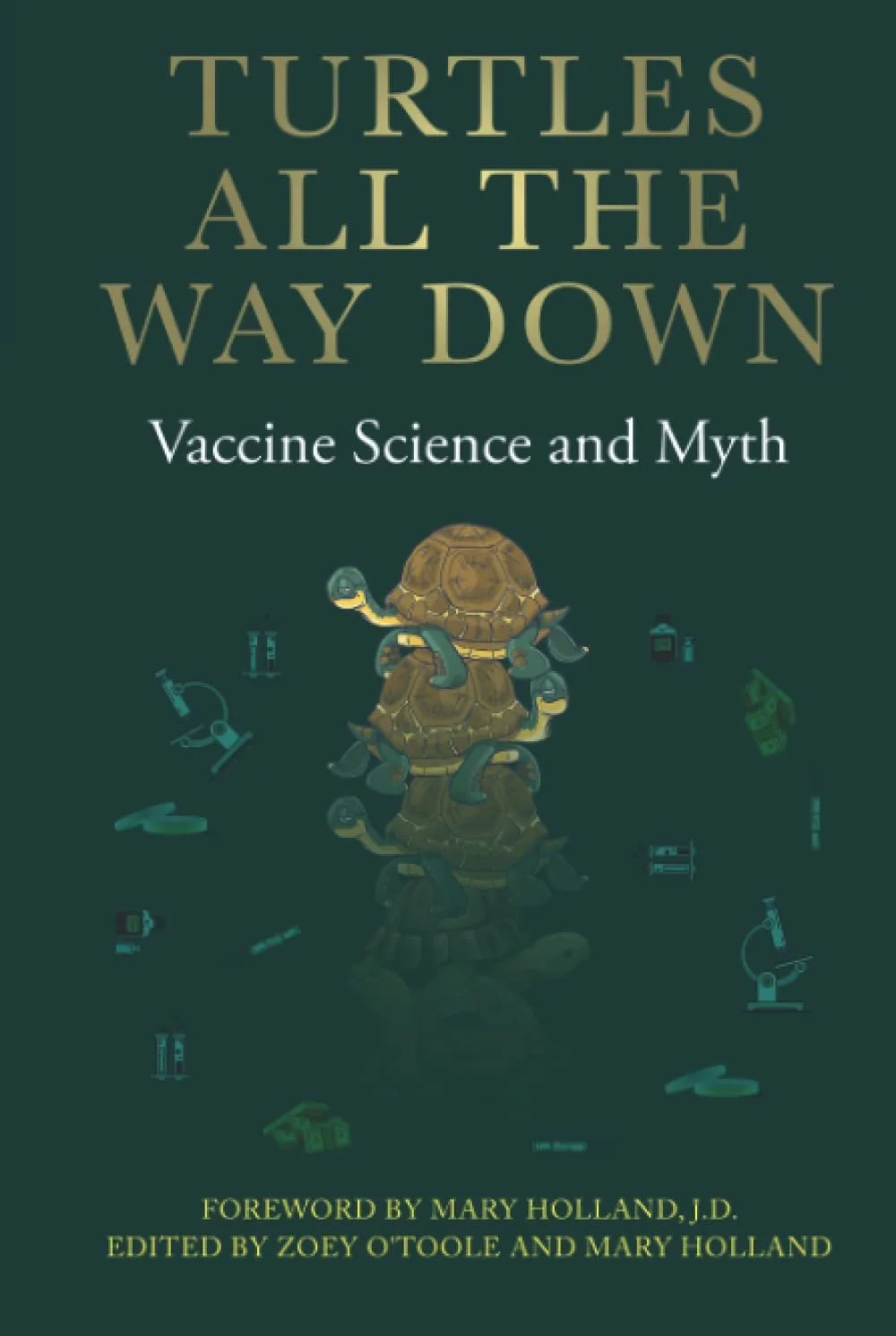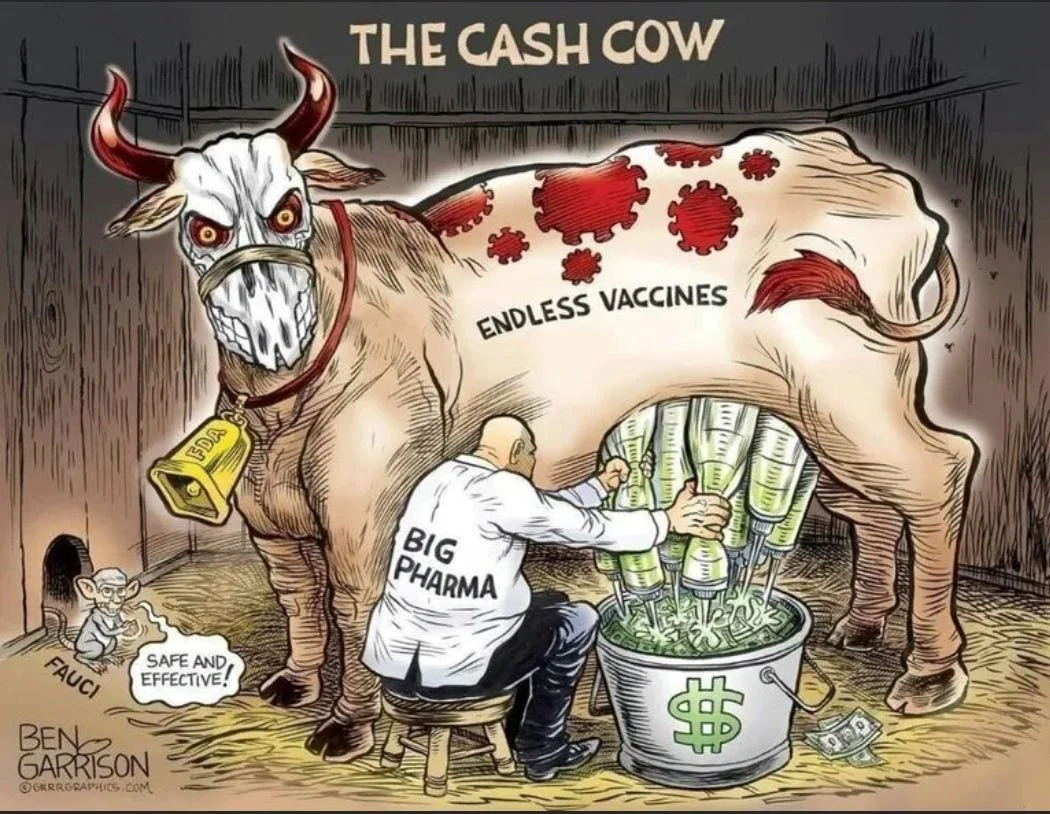Why Read "Turtles All the Way Down"?
Essential reading for parents and all who want to understand vaccine safety "science"
Turtles All The Way Down, Vaccine Science and Myth
by Anonymous (Author), Zoey O'Toole (Editor), Mary Holland J.D. (Editor, Foreword)
Introduction and Commentary
Robert W. Malone, MD, MS
Parents who have paid attention to the details of the COVID crisis that began in 2019 now confront a challenge that few are prepared for. How to navigate a modern medical and public health system which seems unhinged, and cannot be relied upon as a trusted source of sound medical advice and decision making regarding childhood vaccination? Arbitrary, capricious, disingenuous and counterproductive public health management and messaging decisions have plagued national and global responses to wave after wave of SARS-CoV-2 viral variant infections. Schools have mandated experimental vaccines, and some have sought to circumvent parental permission requirements.
Having lived through the shifting narratives concerning the safety and effectiveness of various gene therapy-based SARS-CoV-2 (COVID) vaccines, many parents have begun to question the entire childhood vaccine enterprise. When the US FDA, CDC, European Medicines Agency and the World Health Organization have made so many mistakes during the time of COVID, parents reasonably ask how can these organizations be relied upon to protect the health of my child?
Once that shadow of doubt creeps into the mind of any responsible parent, things get really complicated. Parents are bombarded by a bewildering mixture of information and propaganda, media spin, overt and covert advertising, and pressure from every direction. How do you make some of the most critical health decisions you may ever face – when and what vaccines to allow your child to receive? Pediatricians, public health officials, and school administrators insist that you must administer the current full spectrum of childhood vaccines. You review the schedule, and find that the list of mandated injections is much longer than what you received when you were a child. You start reading about this new schedule and discover the financial and bureaucratic incentives which drive each of these stakeholders to insist that your child must be injected again and again, literally beginning at birth (or before, while still in mother’s womb via maternal vaccination).
This book, “Turtles All The Way Down, Vaccine Science and Myth” has been developed by anonymous authors to help parents and those not medically trained to understand the issues and work through decisions regarding vaccination of their children. Why do the authors remain anonymous? Because this topic has become so highly politicized and weaponized to the point that any physician or scientist who questions the approved public health narrative regarding childhood vaccination risks public ridicule and loss of livelihood.
At this point in time, during and after COVID, each parent confronts a difficult decision, a choice between either trusting their own ability to make medical decisions for their child, or relying on a dysfunctional medical and public health system. A system which often seems more focused on supporting biopharmaceutical industry and bureaucratic interests than on protecting the precious life and health of each individual child. The easy path is to just transfer responsibility to the State. Let the bureaucracy and medical care system make the decisions for you, after all they are the experts, right?
Then you remember how these same experts have destroyed lives, economies, civil rights, personal freedom, and have run roughshod over fundamental bioethical principles such as the right to informed consent as well as parental rights. And you remember the repeated (false) assurances by these same bureaucracies and medical care providers that the genetic vaccines were fully safe and effective in preventing infection, replication, and spread of SARS-CoV-2 virus by both children and adults.
Modern parents confront an abyss, a unique personal hell. Who can you rely on for advice on whether to vaccinate your child? How can you make such a monumental decision by yourself? If you choose to take personal responsibility for deciding what (if any) vaccines your child should receive, and when these should be administered, how do you make these decisions when you are not trained to sift and evaluate the complicated, bewildering information landscape (and battleground)? What if you chose to not have your children take an injection and they later develop the disease which the vaccine purports to protect against? What if you elect to accept a vaccine and your child develops a vaccine-related injury? As if parenting was not already challenging enough, now parents face a set of decisions with potential catastrophe awaiting no matter which option they choose.
These are among the most difficult questions for a parent to answer, as there is risk on either side. No vaccine, pharmaceutical or medical intervention is either completely free of risk or perfectly effective. Every person’s immune system is different; each child is unique and therefore has unique strengths and weaknesses when it comes to infectious disease risks.
The most generous interpretation of the underlying drivers of this problem is that those entrusted with making vaccine recommendations on behalf of the State public health bureaucracy, those with Masters of Public Health (MPH) degrees, are taught to focus on the greatest good for the greatest number and set policy accordingly. Unfortunately, Utilitarian decision making based on statistical projections is highly susceptible to many forms of bias; small shifts in assumptions can lead to big changes in aggregated risk/benefit ratios, and even in the best circumstances accurate detailed data are required but never fully available. All statisticians, computer scientists, and quantitative analysts know that garbage in = garbage out for any statistical calculation. The inconvenient truth is that a wide range of conflicts of interests, both hidden and acknowledged, compromise the integrity, independence and objectivity of the current vaccine risk/benefit evaluations and recommendation process as practiced in the USA, WHO, EMA and many other countries. Furthermore, what is best for the “average” child may not be the best decision for your child.
The most obvious examples of these conflicts of interest include the twin paradoxes of a US Center for Disease Control and Prevention which is funded to both promote vaccine use and evaluate vaccine safety, and an FDA which is largely funded by the biopharmaceutical industry which it regulates. And if this were not bad enough, the majority of the data upon which these “utilitarian” recommendations and mandates are based are the product of studies which are designed and managed by the very corporations who seek to market these vaccine products. The fox is not just guarding the henhouse, but is also designing the structure, selecting the hens, counting the eggs, and is responsible for reporting and interpreting any losses to guard dogs who wish to join the fox in this gig upon retirement from guard duty.
Sticking with barnyard metaphors, then we have the cash cow functional vaccine monopolies. The modern vaccine enterprise is enormously profitable- if you are the company who managed, at some point in history, to have your vaccine added to the childhood vaccine schedule. In the United States (and most of the western world), once a vaccine is approved for children, the State typically automatically directly purchases or largely subsidizes purchase of the product for distribution to children, and in most cases creates a perpetual market by mandating its use. To encourage companies to remain in this rigged game, the State also typically assumes the cost of providing liability coverage. Furthermore, the bioethical and statistical logic which has been assembled mandates that any new vaccine for that indication must be shown to be superior to the current product in either safety, efficacy or both while still being at least equivalent in all other important parameters.
The reality is that demonstrating statistical superiority in protection (efficacy or effectiveness) against an infectious disease relative to an existing vaccine which is at least partially effective requires much, much larger clinical studies than were required to demonstrate effectiveness of the initial vaccine against some non-specific control intervention. Just to provide some context, the cost per patient enrolled in a vaccine safety and efficacy trial is typically in the range of $10,000 to $20,000 US. This creates enormous financial (and time) barriers to entry for any new vaccine which might be safer, less expensive, or more effective. Vaccines which are at least partially effective have already been developed and deployed for most of the major childhood infectious diseases. Any “new and improved” vaccine therefore must be tested in an environment where the baseline incidence of the disease is lower (typically due to improved sanitation, living standards, as well as partial vaccine effectiveness) than when the original vaccine was developed. This circumstance then requires even larger clinical trial enrollment, and even higher financial barriers to entry for an improved vaccine product. Consequently, there is a perverse incentive to identify and pursue new product opportunities rather than compete to improve existing vaccines, to rush vaccine products for novel indications to market, and once licensed to never re-open the regulatory dossier for those products (and companies) that manage to grab the brass ring. And so more and more vaccines are developed for more and more new indications, and the childhood vaccine schedule is constantly growing. Furthermore, current policies only require that each vaccine product be tested by itself, not in combination with the other vaccines already approved for children. Therefore, interactions between different vaccines which might impact efficacy, effectiveness or safety are never addressed.
Then there is the general issue of assessing vaccine safety. Safety is relative. There is no objective universal criterion for an acceptable level of safety. Prophylactic vaccines are typically administered to children (or adults) who are not currently suffering from an infectious disease, the ethics of which require unusually high safety criteria. To illustrate the point, imagine a child with a rare life threatening cancer of the blood which, if untreated, will (on average) result in death within 12 months. A cancer (chemotherapeutic) drug or radiation treatment which may damage their DNA resulting in a 30% risk of developing a new life threatening cancer within 20 years but which is likely to cure the current cancer might provide a reasonable treatment option. Administering the same drug to all children just in case they might (or might not) have that rare blood cancer would be ethically insane. So, how can a parent (or a physician) rationally decide if a vaccine product is sufficiently safe? You have to start with a solid understanding of the risks of the infectious disease. What are the short and long term risks of the disease given current treatment options? What is the risk that the child will develop the disease in the world as it currently exists?
The answers to these questions are constantly shifting and evolving depending on geography, treatment advances, local sanitary conditions, socioeconomic context, individual health, and availability of medical care. Mid-20th century childhood infectious disease risks are very different from those faced by 21st century children (and their parents). And, on average, these risks change as a child grows from infant to adult. Different types of clinical risks have different impacts on short and long term health and functionality. Consequently, there are no simple answers or statistical algorithms which can completely predict an acceptable risk for a vaccine. Determination of acceptable risk is subjective. One persons’ version of “safe” is not universally accepted by all others. Therefore, there can never be a universal objective determination of “safety” for a vaccine. The statement that a vaccine is “safe for children” is a non-sequitur. Safety is always relative. To state otherwise is mere propaganda or marketing.
Even more than with determining efficacy or effectiveness, the complexity and cost of assessing “safety” is enormously difficult (and subjective). In general, fundamental statistical methods, calculations and limitations make this particularly vexing. Imagine a Phase 1 clinical trial, the initial stage of testing a vaccine product in humans. When designing the trial, there is no way of really knowing how safe or effective the product will be – it has never been tested in humans before. So a variety of safety tests are first performed in animals, and the vaccine product is also tested for ability to either generate an immune response in animals and/or to provide protection against a “challenge” with an infectious agent. To keep from having to test hundreds or thousands of animals, the dose of vaccine tested in the animal model is typically much higher (based on body weight) than the dose proposed for humans. The logic being that it the product has a toxicity, then if you administer more of it, you will see more toxicity and this will be easier to detect and the disease will develop more rapidly. The infectious challenge dose is also often proportionally much higher than a human would be exposed to, so that all test animals will get disease if not vaccinated. For these reasons, and the fact that no animal perfectly models a human, these non-clinical (animal) studies are relatively poor predictors of efficacy and safety in humans. Furthermore, the general advice in the biopharmaceutical industry is to never perform a study that the regulatory authority does not require, as an unexpected outcome could damage the viability of the product candidate. Consequently, as the vaccine enters initial human (clinical) testing, it is important to go slow and test limited numbers of patients or subjects in a stepwise fashion.
A typical Phase 1 vaccine trial might enroll up to 30 human subjects. Let’s imagine that none of those subjects develops any serious medical problems after vaccination- the vaccine must be safe, right? Statistically, all that means is that in that group of patients, on average, no more than one out of every ten treated patients are likely to develop a serious medical problem within the period of time that they were enrolled in the clinical trial. But what if we want to detect a possible vaccine damage that is rare but life threatening? For example, clinically significant myocarditis occurring at a rate of one case in every 3,000 vaccinated children? Reliably detecting even a single such event would require, on average, enrolling 9,000 children in a clinical trial; this simple estimate of trial enrollment size is known as “the rule of three”. At $10,000 per subject, that trial would be a 90 million dollar investment. At a more realistic $20,000 per subject, we are talking about an 180 million dollar trial. Now imagine a childhood infectious disease that only kills or severely disables one out of every 100,000 infected children. Surely the risk of the vaccine should be less than the risk of the disease, so a “safe” licensed vaccine should not cause death or serious disease more frequently than one child in every 100,000 children completely vaccinated. This would necessitate a “safety database” of at least 300,000 vaccinated children at (say) $20,000 per child, or roughly six billion dollars- which would reliably only detect one such rare event! And that does not even include a placebo control group to insure that the results are not just detecting random noise! Which leads us to the title of this book.
Turtles all the way down. This curious title is a metaphor for the hidden truth which underlies the “safety” assessments underpinning the modern childhood vaccine schedule. The data often cited as demonstrating the safety of these mandated medical products is akin to fantasy author and humorist Terry Pratchett’s “Diskworld” series, in which a flat earth rests on the back of elephants, which in turn stand on the back of an enormous turtle. And what supports that turtle? In this version of the flat earth myth, another turtle, which stands upon another, all the way down.
The World Turtle, also called the Cosmic Turtle or the World-bearing Turtle, is a myth-eme of a giant turtle (or tortoise) supporting or containing the world. It occurs in Hindu mythology, Chinese mythology, and the mythologies of the indigenous peoples of the Americas.
Similarly, one of the most stunning findings documented in this book is that virtually all childhood vaccine clinical trials are allowed to use other vaccines as “control” comparators. And the safety of these controls has been evaluated by comparing to prior vaccines. A statistical house of cards. A sort of Ponzi scheme. Turtles standing on the back of turtles, standing on the back of turtles, all the way down.
None of which products have been formally and rigorously assessed for safety in the context of the overall expanding childhood vaccine schedule. Each of which include components which non-specifically stimulate inflammation, and are reasonably likely to interact. What is inflammation? The classic definition is a combination of redness, swelling, heat and pain. This is the most inconvenient of the many vaccine truths revealed in this stunning volume. The truth is that the cumulative adverse effects of the ever expanding childhood vaccine schedule have not been evaluated, and the individual toxicities of each separate vaccine have never been compared to a true negative control using the modern accepted clinical designs and statistical methods which are mandated for almost all other classes of biopharmaceuticals.
Whatever your choice, to trust the State and your personal pediatrician to guide decisions about vaccination of your child, or to accept the burden of that responsibility yourself or together with your family, you owe it to your children to take the time to carefully read and understand the points made in this book. There is no “right” or perfect answer, just different levels and types of risk. Anyone who tells you otherwise is either ignorant, a fool or has a conflict of interest. It is your child, your family, and your future.
Get informed, and choose wisely.
From the publisher:
If you are reading this, you are probably aware of the fierce debate surrounding vaccination and looking for information that will allow you to make the best decisions for yourself and your loved ones. Whether you are a parent or a parent to be, sorting through the many arguments on vaccines can be daunting. Still, you need an answer, a definitive one, to the crucial question: Who has it right in the great vaccine debate – the critics, who claim that vaccines often cause serious harm, or the medical establishment, which tells us that vaccines are safe and effective and the science is settled?
Rest assured, you have come to the right place. Turtles All the Way Down: Vaccine Science and Myth will resolve the vaccine question for you, once and for all. By the time you finish reading, not only will you see the answer clearly for yourself, you will also have the scientific references and specific quotes at your disposal that prove it – more than 1,200 of them – all from mainstream scientific papers and textbooks, the official publications of relevant government agencies, or manufacturers’ documents.
The book consolidates a great deal of information (accompanied by detailed analysis) that is scattered in hundreds of medical articles, books, and websites. All discussion is presented in clear and easy-to-understand language, so no medical education is required. It presents several original concepts in addition to laying a robust scientific foundation for the more established ones.
Some of the fundamental vaccine safety issues covered in the book are:
How is safety demonstrated before a new vaccine is licensed? What technique do vaccine manufacturers use in clinical trials to make vaccines appear safer than they actually are?
What “last ditch” technique is employed when the above one cannot be, and what are its grave (and damning) ethical implications?
What is the scientific foundation of the safety of vaccination, and what practical tools does this body of science provide physicians to anticipate, diagnose, and treat vaccine injury?
What fundamental flaws are built into vaccine adverse events reporting systems, and how are these systems used (or misused) by health authorities to support their safety claims?
What kinds of post-marketing vaccine studies are conducted, and how can they be manipulated by researchers to produce “favorable” outcomes?
Why would researchers want to skew vaccine research, and how could skewed results be promulgated by the scientific community?
Why would medical journals publish faulty vaccine science? What is the role of the famed “peer review” in this process?
What are “the studies that will never be done” by the medical establishment and how long it has resisted doing them? (Hint: more than 100 years!)
What key CDC-recommended childhood vaccination guidelines were arbitrarily set, without an adequate scientific basis?
In addition, three cornerstones of vaccination lore are covered in depth:
What is herd immunity, and how does it apply (or not) to the vaccines on the childhood schedule?
What role did vaccines actually play in the historical decline of infectious disease?
Was the paralysis associated with polio actually caused by the poliovirus? Is there a better explanation for the great paralysis epidemics of the 20th century? What are the “19 polio mysteries”?
The book is intended for parents overwhelmed by conflicting messaging on this important topic, but it is also an excellent reference for medical researchers and professionals who seek a better understanding of vaccine safety science. Whether you are new to the vaccine debate or a “veteran” seeking a deeper grasp of the science, this book is a must-read. It also serves as an excellent primer on vaccination to share with friends and relatives who may benefit from a deep dive into the subject.



